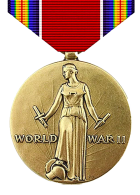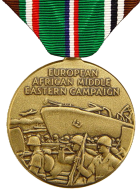My name is Bob Coop, Robert Coop. I grew up I was born in San Diego, California. And I grew up in Pasadena where my father was a fire chief; and that added a lot to my experience in growing up in Pasadena. I went to the University of California; graduated in 1935. Lived in the one dorm they had then, Bowles Hall. I was active in the government of the Bowles Hall; and I road on the crew. I road under the very famous and wonderful man, Ky Ebright, whom, everybody who was associated with that sport knows, knows well. He's gone now, of course. I then had a chance to go to graduate school at the University of Southern California and got a master's of science in public administration, which turned out to be my field. I've served in several capacities. Maybe I guess we'll get into those as we talk about this. But, for the record, I guess, my serial number is 149824. I guess that's about it.
After special training in the United States, I was assigned to a Special Support Group for Naval Operations. My fellow officers and I were happy because we thought that this meant that we would be providing special support to our invasion forces...perhaps carry bread and other food from England to the invasion forces where ever they might be. We soon learned that "special support" meant gunfire support and that we would be up front rather than behind. So much for being a Support Ship!
We sailed to Scotland on the transport Queen Elizabeth, along with 15.000 other passengers. The Queen went so fast that we sailed alone rather than in convoy. No enemy submarines or raiders showed up. I had my own cabin in what had been first class, but there were fifteen other officers in the same cabin stacked three deep. Upon arrival in Scotland, our crews were formed and we were assigned to our ships. The ships were built on the River Clyde famous British shipping building area. They were built specifically fo the invasion and were turned over to the U.S. Navy to be manned by U.S. sailors.
It was not anticipated that these ships would have a long life expectancy, but we fervently hoped that the crease would. (These ships we known as the Landing Craft Gun (Large) which was a British landing craft which had been modified as a Gun Ship for the U.S. Navy. (For a short history of the USLCGLs in Mr. Arthur Willey's story on this webpage) We had Flak ships for defense against hostile aircraft; Rocket ships for mass firing of rockets to saturate the beaches with five inch rockets; and LCGLs for firing at specific targets on the beaches. After sailing to the south of England, we trained in the English channel and along the south coast.
Some of us participated in the fateful training exercise "Operation Tiger" at Slapton Sands, near Salcombe, which ended in disaster when enemy E boats infiltrated and sunk several of our ships loaded with troops who were embarked in LST's for the training. The operation was so large, and so secret, that we did not know of the tragedy until several months later. The public was not aware of it until years later. I was the commander of USLCGL 687. At times, when our commander left base, I was placed in command of the entire LCGL Flotilla. We set off in convoy with other assault ships under the cover of darkness on June 4th, 1944, and at daybreak we received a signal to return to base. The whole operation Neptune had been postponed. After the emotional buildup and acceptance that we were finally on our way, to be ordered to return to England was very frustrating.
Early in the morning of June 5th, we reformed and proceeded in rough but not impossible weather toward France and our targets. We knew this was "it!" We arrived at the rendezvous area some 10,000 yards off the coast at 4:00 AM on D-Day, June 6th, and then proceeded independently toward the beach. Our first targets were at Fox Green sector, in support of the 1st infantry division. We were hit with shrapnel, but we had no casualties. We opened fire with our 4.7 inch guns promptly at 6:00 AM at about 1000 yards and ceased fire at 6:27 less than 200 yards off shore!
During this time the Rocket ships were directly astern of us firing banks of two hundred rockets at a time over our heads toward the beach. I was worried that if we went up on a high wave and the rocket ship went down that we would be hit! At promptly 6:30 the first assault small boats with our troops and some small artillery moved toward the shore in heavy seas. By this time, ships of every size and description were massing: Battleships, cruisers, destroyers, gunships, large and small landing craft and support craft. At 12:05 we received a message by radio from LCH 520 to move to the right flank of Omaha beach and engage enemy machine gun emplacements which were holding the exit to Dog Green beach (29th division sector). The LCGL 687 commenced firing at designated target at 12:27. The estimated range was 1500 yards.
We expended many rounds. At one point we were ordered to prepare to land on the beach in support of the landing infantry there. We had m1 carbines on board and we prepared to go in as infantry. However, the order never came and our troops began to make progress toward the bluffs. On June 7th, we received a visual message from DD 472 suggesting the LCGL 687 investigate a small German craft inside the breakwater at Port En Bessin. We proceeded, along with USLCG(L) 426, to the Port. We observed the German craft through the gap in the sea wall and opened fire with A gun and Oerlikons 4 and 6 at 1259. We ceased firing at 1309.
The target was neutralized. We expended 30 rounds S.A.F., 6 rounds H.E. and 36 cordite, also expended 720 rounds from the Oerlikons. We had no casualties. On June 9th, we had an encounter with a German plane. we believe it was an ME 210, or possibly a JU 88. The plane approached the ship from port bow at an estimated height of 1,000 yards. Oerlikons 2,3,5,6, and 7 fired a total of 300 rounds and it is believed that the plane was hit by our fire. The plane was fired on by an unidentified LST anchored off our starboard quarter and was seen to break in half and fall into the sea. It is believed that our ship's fired contributed to the destruction of the plane.
We continued to patrol the land areas until the 12th of June. We were ordered to convoy assembly area near H.M.S. GERES. We dropped anchor in company with the USLCG(L)'s and LCT(R)'s from assault Force Utah. At 0732, 13th of June, we proceeded on convoy course for Portland harbor in England. We dropped anchor in Portand Roadstead at 0230, 14th of June, 1944. My father immigrated from England. I was very proud to serve on a ship that came from the British Navy. As the captain of my ship I can report that my men performed bravely and well, but when all is said and done, it was the American, British, and Canadian soldier who faced murderous enemy counter fire with almost unbelievable determination.
As I watched this terrible drama unfold standing on the bridge of my ship, I coudn't help but realize that when the war moved beyond the beaches, my ship and crew would be going back to England for further assignment.However, each soldier would be going forward until the enemy was totally and completely defeated and brought to surrender or until injury and death resulted. As terrible as the war was in those fateful days of 1944, there probably never was a time in our nation's history when the American people were more united in a common purpose and goal.
People accept responsibility in many ways, doing jobs they had never done before, making sacrifices, shouldering grief at the loss of friends and relatives and working together. What a shame that it takes a war to bring us together. Why can't we do this in times of Peace?
God Bless You All,
Bob Coop







